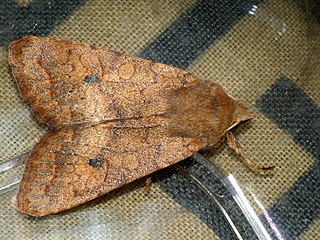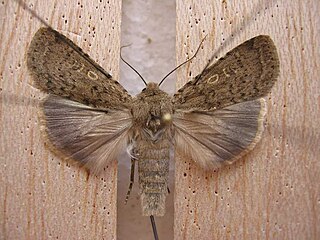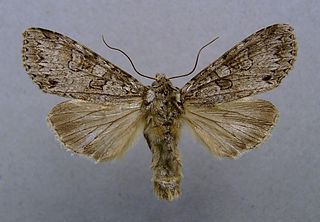
The small fan-footed wave is a moth of the family Geometridae. The species was first described by Johann Siegfried Hufnagel in 1767.

The garden dart is a moth of the family Noctuidae. It is distributed throughout much of the Palearctic. Temperate regions of Europe, Central Asia and North Asia, as well as the mountains of North Africa. Absent from polar regions, on Iceland and some Mediterranean islands, as well as in Macaronesia.

The bright-line brown-eye is a moth of the family Noctuidae. The species was first described by Carl Linnaeus in his 1758 10th edition of Systema Naturae. It is a common species throughout Europe, but is also found in North Africa, temperate North Asia and Central Asia, Asia Minor, Syria, and Turkestan, northern India, China, Korea and Japan.

The broad-barred white is a moth of the family Noctuidae. The species was first described by Johann Siegfried Hufnagel in 1766. It is distributed throughout Europe and is also found in Turkey, Iran, Israel, Lebanon, Syria, Kirghizia, Tajikistan, western Siberia and China.

Eupsilia transversa, the satellite, is a moth of the family Noctuidae. The species was first described by Johann Siegfried Hufnagel in 1766. It is distributed throughout the Palearctic.

Agrochola circellaris, or The Brick, is a species of moth of the family Noctuidae. The species was first described by Johann Siegfried Hufnagel in 1766. It is distributed throughout most of Europe, Asia Minor and Armenia.

The straw underwing is a species of moth in the family Noctuidae. The species was first described by Johann Siegfried Hufnagel in 1766. It is found from North Africa west through South Europe and Central Europe. In the north it is in parts of Ireland, Scotland, Sweden, Norway, Finland and Estonia. Further east the range stretches from southern Russia and Asia minor to the Caucasus.

Apamea monoglypha, the dark arches, is a moth of the family Noctuidae. The species was first described by Johann Siegfried Hufnagel in 1766. It is a common, sometimes abundant, European species. It is found in most of Europe except northernmost Fennoscandia and the southern parts of the Iberian Peninsula and Greece. The species is also found in Anatolia, Turkestan, Western Asia and Central Asia, Siberia and Mongolia. In the Alps it is found up to heights of 2,500 meters. The smaller subspecies sardoa is found on Sardinia and Corsica.

Apamea sordens, the rustic shoulder-knot or bordered apamea, is a moth of the family Noctuidae. The species was first described by Johann Siegfried Hufnagel in 1766. It is distributed throughout Europe, east across the Palearctic to Central Asia and to China and Japan. It also occurs in North America.

Lacanobia thalassina, the pale-shouldered brocade, is a moth of the family Noctuidae. It is found in Europe east across the Palearctic to the Russian Far East and Siberia.

Pyrrhia umbra, the bordered sallow, is a moth of the family Noctuidae. The species was first described by Johann Siegfried Hufnagel in 1766. It is found in all of Europe, east through Anatolia to Iran, Afghanistan, Pakistan and Nepal and through central Asia to Japan. In mountains it can be found up to elevations of 1,600 meters.

Eurois occulta, the great brocade or great gray dart, is a moth of the family Noctuidae. It is found in northern and central Europe, North Asia and central Asia to the Pacific Ocean and Japan. Also the northern parts of North America. In addition, it is found in Greenland and Iceland. In the south in northern Spain and on the Balkan peninsula.

Lacanobia is a genus of moths in the family Noctuidae.

Pachetra is a monotypic moth genus of the family Noctuidae erected by Achille Guenée in 1841. Its only species, Pachetra sagittigera, the feathered ear, was first described by Johann Siegfried Hufnagel in 1766. It is found in central and southern Europe, east to the Ural, north to southern England, Sweden and Finland. Southwards it is found from Anatolia, central Asia and the Altai up to Mongolia. It is also present in North Africa.

Lacanobia contigua, the beautiful brocade, is a moth of the family Noctuidae. The species was first described by Michael Denis and Ignaz Schiffermüller in 1775. It is found throughout temperate regions of the Palearctic realm, from Ireland east to Siberia and Japan.

Agrotis vestigialis, the archer's dart, is a moth of the family Noctuidae. The species was first described by Johann Siegfried Hufnagel in 1766. It is found in most of the Palearctic realm from Ireland east, through to Russia, Siberia, the Altai Mountains and the Amur region, and is also present in the Mediterranean Basin. It is absent from the north of Finland and Norway.

Rhyacia simulans, the dotted rustic, is a moth of the family Noctuidae. The species was first described by Johann Siegfried Hufnagel in 1766. It is found in most of Europe, south to Morocco, Algeria and Tunisia, east to Turkey, the Caucasus, Tomsk and Minusinsk.

Lithophane socia, the pale pinion, is a moth of the family Noctuidae. The species was first described by Johann Siegfried Hufnagel in 1766. It is found throughout western Europe from Spain to central Scandinavia then east across the Palearctic to Siberia, the Russian Far East and Japan.

Polia nebulosa, the grey arches, is a moth of the family Noctuidae. The species was first described by Johann Siegfried Hufnagel in 1766. It is found in temperate Europe and Asia up to eastern Asia and Japan. It is not present in northernmost Fennoscandia and the southern parts of the Iberian Peninsula, Italy and Greece. In the Alps it is found at heights up to 1,600 meters.

Eriopygodes imbecilla, the Silurian, is a moth of the family Noctuidae first described by Johan Christian Fabricius in 1794.





















